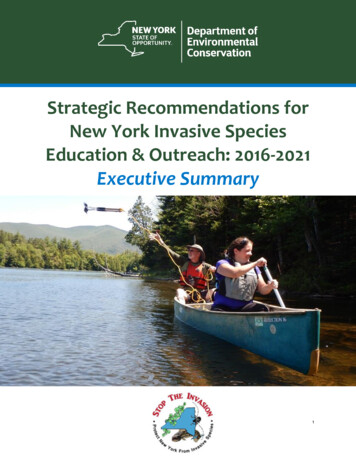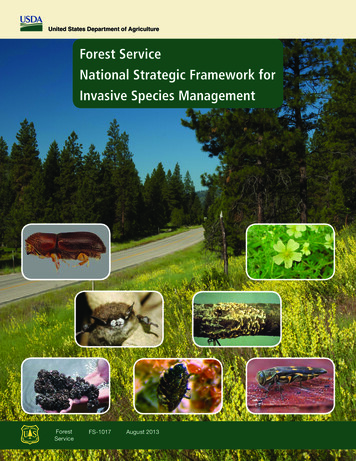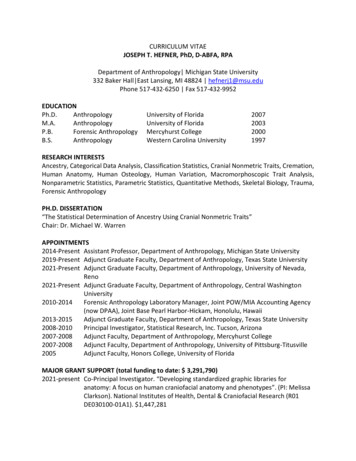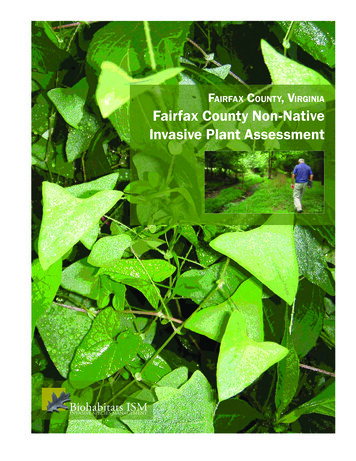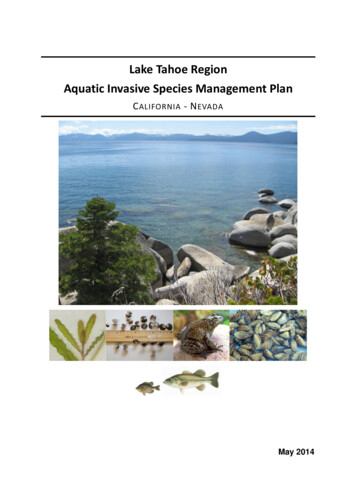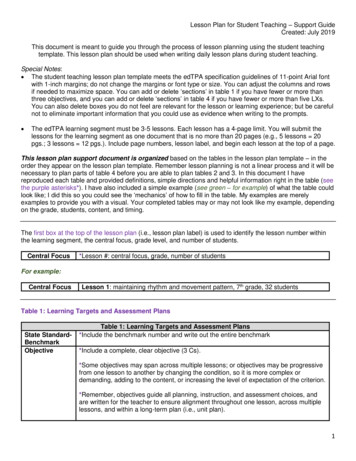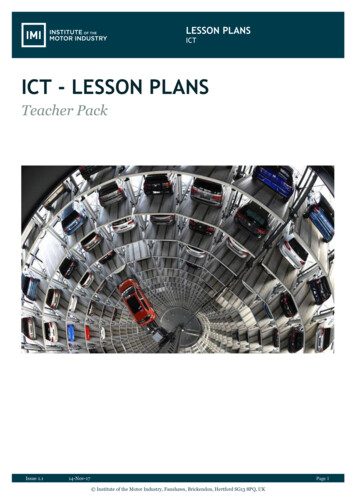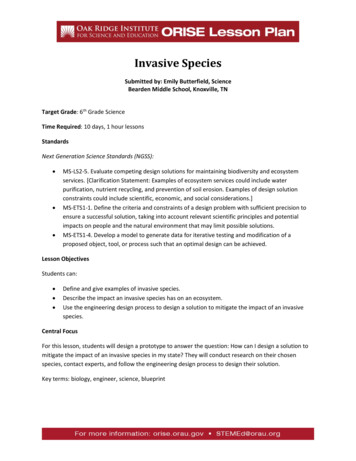
Transcription
Invasive SpeciesSubmitted by: Emily Butterfield, ScienceBearden Middle School, Knoxville, TNTarget Grade: 6th Grade ScienceTime Required: 10 days, 1 hour lessonsStandardsNext Generation Science Standards (NGSS): MS-LS2-5. Evaluate competing design solutions for maintaining biodiversity and ecosystemservices. [Clarification Statement: Examples of ecosystem services could include waterpurification, nutrient recycling, and prevention of soil erosion. Examples of design solutionconstraints could include scientific, economic, and social considerations.]MS-ETS1-1. Define the criteria and constraints of a design problem with sufficient precision toensure a successful solution, taking into account relevant scientific principles and potentialimpacts on people and the natural environment that may limit possible solutions.MS-ETS1-4. Develop a model to generate data for iterative testing and modification of aproposed object, tool, or process such that an optimal design can be achieved.Lesson ObjectivesStudents can: Define and give examples of invasive species.Describe the impact an invasive species has on an ecosystem.Use the engineering design process to design a solution to mitigate the impact of an invasivespecies.Central FocusFor this lesson, students will design a prototype to answer the question: How can I design a solution tomitigate the impact of an invasive species in my state? They will conduct research on their chosenspecies, contact experts, and follow the engineering design process to design their solution.Key terms: biology, engineer, science, blueprint
Background InformationFor this lesson, students will build upon prior knowledge of invasive species and the impact they canhave on the environment. Key terms to be aware of are the following: Invasive species: nonindigenous species that spreads from the point of introduction andbecomes abundant. The invasive species label attaches only to populations of species whoseimpact upon introduction has altered their new environment.Overpopulation: occurs when a species' population exceeds the carrying capacity of itsecological niche. It can result from an increase in births, a decline in the mortality rate, anincrease in immigration, or an unsustainable biome and depletion of resources.Ecosystem: a community of living organisms in conjunction with the nonliving components oftheir environment, interacting as a system. These biotic and abiotic components are linkedtogether through nutrient cycles and energy flows.Students should be aware of the engineering design cycle prior to this lesson. These steps include thefollowing: Define the Problem, Collect Information, Brainstorm Solutions, Develop a Solution, Build aPrototype, Present Your Ideas to Others for Feedback, Test and Redesign. The process is never reallycomplete, as there can always be additional improvement. Students also need to be aware of the safetyprecautions in using some of the makerspace materials. It is advisable that the teacher does notintroduce new tools in this lesson, but instead uses only the tools students are familiar with already, as asafety precaution.Figure cess.png
Materials Pre-QuizVideo: TED ED “Invasive Species” https://youtu.be/spTWwqVP 2sCornell Note Paper (regular notebook paper or digital note taking could also be used)Pencils/writing utensilsAccess to technology and internet for research purposesAccess to a library for research purposesPrinted copies of articles on invasive species with varying reading levelsMeans of communicating with experts (email/phone)List of possible experts/resource personsStudent project guide (digitally and in print)Post-it notes or small pieces of paperVarious building materials and craft supplieso Cardboard, scissors, glue, pipe cleaners, popsicle sticks, clean food containers, toiletpaper rolls, etc.Feedback formsPractice QuizPost-QuizRubric for scoring project sheet and final productInstructionDay 1 To begin the class, have students watch the TedEd video on invasive species.o Video Link: https://youtu.be/spTWwqVP 2sAfter watching the video, have the students engage in a discussion to answer the question, “AreHumans an Invasive Species?”o Before starting the discussion, have the students write down a response to the promptwith evidence to support their claim.Next, the teacher will introduce the standards and the essential question.o Essential Question: How can I design a solution to mitigate the impact of an invasivespecies in my state?Next, allow time for students to take a short pre-quiz to gauge their understanding of invasivespecies coming into the lesson.o Have students generate questions they need/want to answer based on their pre-quizand curiosity.o Students will prioritize questions by sorting them into 3 categories: Priority 1: Must know to be successful on the project and assessments. Priority 2: Need some review on this concept and/or builds upon a priority onequestion.
Priority 3: On topic and interestingbut would be consideredenrichment and not the mostimportant to answer for project orassessments.Using any notebook paper, have students set up apage for Cornell notes.o Student’s notes set up should look similar tothe example photo. Summary section can betaken out to allow for more room forquestions.Have students write their questions in the leftcolumn.o As students conduct research, they will addtheir answers to the right side column andcan add additional questions to the left side.Once students have recorded their pre-quizquestions, ask students to share one to the class asan end of class discussion. Day 2 To begin class, have students choose an invasive species in their state that they would like toresearch and develop a mitigation solution for.Students will conduct research on their invasive species and add answers to their notes.The teacher will hold check-ins with students to help guide their work and research.At the end of class, have students make a plan of action or “to do” list for the next class period.Days 3 Students will continue research.Experts can be contacted during these days.o Students are required to get approval of their expert with the teacher.o Students should have a script with talking points and questions approved by theteacher.o Emails should be drafted and approved by the teacher.o Contact with outside experts should be supervised by the teacher.o It can be beneficial to ask permission and record all interviews for use by the students,peers, and future use.Remind students about the timeline and check-in with students about what was learned viaclass discussion.
Day 4 Working alone, students will begin the design process by brainstorming possible solutions.After students have chosen their favorite design, have them create a drawn and labeled designof their prototype.Day 5 Have students display their designs on classroom tables.Each student takes a stack of post-it notes and a writing utensil as they do a gallery walk of theother designs.Feedback is given in the format of:o I like .o I wish .o I wonder .Remind students that feedback should be kind, helpful, and specificStudents return to their design and review their feedback.Allow time for students to ask peers about any feedback received.Students will use the feedback to improve their designs.Day 6-7 Students will build their first prototype based on their design.Students will test their design and improve the prototype.Have students get feedback from peers as they work through iterations.Remind students about the timeline and check-in with the student about what was learned viaclass discussion.Day 8 Have students display their prototypes on classroom tables.Each student will take a stack of post-it notes and a writing utensil as they do a gallery walk ofthe other designs.Feedback is given in the format of:o I like .o I wish .o I wonder .Have students use the feedback to improve their prototypes.Remind students about the quiz and stage a quick review with students of what they havelearned.
Day 9 Have students finalize their prototypes, take pictures, and submit the photos and InvasiveSpecies Template in the format designated by the teacher.After submission, ask students to take the practice quiz.Remind students about the timeline and check-in with students about what was learned.Day 10 Have the students take the post-quiz.Students who score below a 70 should plan a course of remediation with the teacher.Construct a class discussion on what the students have learned.DifferentiationDifferent reading abilities and levels Articles at different reading levels:o www.newsela.com Read-aloud articles/text:o www.dogonews.comLimited fine motor skills Modify the project guide to allow for more space for writing or drawing. Peer support in writing or drawing.Visually impaired Larger print on texts Modify packet to have larger text and spaces for writing or drawing.Intellectual disabilities Picture guides Modify feedback to use of symbols, key words, or verbal feedback Adult assistance during building Allow students to build at homeAssessmentFormative assessment: The end of class discussion will allow the teacher to check for progress after each lesson. The pre-quiz and practice quiz will allow both teacher and student to measure their contentgrowth. Student’s notes will allow both teacher and student to check for progress to understand invasivespecies.Summative assessment: The post-quiz will allow both teacher and student to measure their content growth.
The teacher can use the final project submission (photos and Invasive Species Template) tounderstand the student’s mastery of invasive species and how they are harmful to theenvironment.Examples of student work
Name:Class:DUE:EQ: How can I design a solution to mitigate the impact of an invasivespecies in Tennessee?Challenge: Plan, Design, and build a solution to help mitigate the impactof an invasive species in your state.Step 1. DefineWhat Invasive Species did you choose?What sources did you use to find out about your invasive species? Cite your researchsources.(Information found should be added to your notes)Step 2. Ideate.Think about how you might mitigate the impact of your invasive species. Brainstormseveral ideas. Sketch out your ideas and write a description of your drawing.Description (words)Drawing
Step 3. Design your idea (prototype).A. Select the best idea from your brainstorming in step 2 (brainstorming) and highlight it.Draw a detailed design below and label all of the parts of your device. You should have atop, bottom, side, inside, open and closed drawing! Make sure to give measurementsfor the size of your prototype.
B. Identify materials needed (add more lines if necessary)MaterialQuantityStep 4. Create/Build and Test Your Prototype.Test and evaluate your design at least 3 times (you can do more if needed).Complete the table below to show the results of your testing.Trial #Results/Changes Needed and Made123Step 5. ImproveModify and retest your machine. What improvements were made to your design?
5/28/2020LS 2.5 QuizLS 2.5 QuizCollection:DistrictQ1: Why do scientists have to be careful when nding a solution to an invasive species? (choose 3)AInvasive species are hard to transport back to their native locationsBIf an new species is introduced to control the invasive organism, it could also become an invasive species.CChanging how organisms interact can disrupt food websDIf poison is used, other organisms can be harmedQ2: What is an invasive species?Q3: Apple snails live in ponds and are an invasive species. How can they harm the ecosystem?A They wipe out the vegetation and out compete other native snail species.B The snails reproduce and ll up the entire pond.C They decompose dead plants to add nutrients to the soil.D They are producers and change energy from the Sun into food.Q4: How are non-native species and invasive species alike and di view?t 15906768887911/6
5/28/2020LS 2.5 QuizQ5: A group of students studying invasive species proposed bringing in more natural predators to deal with therainbow trout populations in Tennessee streams. How could this have a negative e ect on the ecosystem?Q6: Invasive species can only enter an area if humans bring them.A TrueB FalseQ7: The following graphs shows the population of zebra mussels and its relationship to how clear the water is that itis living in.What facts can be gathered about the zebra mussel from looking at the graph? Choose 2.AZebra mussels prefer water when you are unable to see very deep.BWhen the water is clearer, the population of zebra mussels increases.CZebra mussel population doesn't seem to have anything to do with how clear the water is.DZebra mussel population declines when the water is not very clear.Q8: Japanese honeysuckle is an invasive plant that grows over shrubs and hedges and smothers them out. Which ofthe following would be the most e ective method to help mitigate the honeysuckle?A Use a plane to spray herbicide (plant poison) over the ecosystem to kill the plant.B Find a way to target only the honeysuckle with herbicide (plant poison) so that other plants aren't killedC Go and dig up each honeysuckle plant one at a timeD Kill all of the animals that eat the intPreview?t 15906768887912/6
5/28/2020LS 2.5 QuizQ9: Which of the following human activities reduces biodiversity?A prohibiting hunting in wildlife preservesB gathering samples of animals in an areaC planting only native grass species to help with soil erosionD planting only red pine trees to replace native hardwood forests that have been cut for lumberQ10: The little brown bat has populations in the millions in some caves. These mammals consume insects that areharmful to corn and cotton. It is estimated that a community of a million bats consumes 10 tons of insects eachnight. As the population of bats increases, it would be expected that the crop production in the area would--A not changeB be cut in halfC show minimal responseD steadily increaseQ11: The loulu tree in Hawaii reproduces by a seed surrounded by a fruit. Nonnative species such as pigs and ratseat the fruit as a part of their diets, which lowers the reproduction rate of the luolu tree. What most likelywould be the outcome of the loulu tree in the next century if this trend continues?A They would become extinctB They would nd a di erent way to reproduceC They would relocate to get away from the animals that are eating themD Nothing would change about the number of iew?t 15906768887913/6
5/28/2020LS 2.5 QuizQ12: A species of giant panda lives only in Central China. Bamboo, a tall, green, tropical plant is the main food sourcefor these pandas. Large areas of bamboo are being cut down in China to make room for other crops.What will most likely happen to these giant pandas?A they will have to nd another food sourceB they will become endangered or extinctC they will begin to live in cavesD they will become carnivoresQ13: A new species of snake was introduced to a tropical region. Scientists then noticed a steady decline in thenumber of eld mice in the area and an increase in the number of snakes. Which of these is the most likelyexplanation about why the population size of each animal changed?A The snakes introduced to the region dominated the habitat, forcing the mice to nd a new place to liveB The mice became prey to the introduced snakes, allowing the snake population to increase, but decreasing the mousepopulationC The snakes introduced to the region competed with the mice for food, allowing the snake population to increase, butdecreasing the mouse populationD The people in the surrounding area set traps that killed the mice, allowing the snakes to live without any predators, andhence increase in numbersQ14: Brown tree snakes were accidentally carried to the island of Guam by the cargo bays of military planes afterWorld War II. Brown tree snakes prey upon birds. There are no natural predators of brown tree snakes inGuam.Which of the following most likely happened as a result of the arrival of the brown tree snakes in Guam.A Forest biodiversity increasedB Many bird populations decreasedC No new bird species arrived in the areaD All reptiles species had an increase in population view?t 15906768887914/6
5/28/2020LS 2.5 QuizQ15:Adedes Albopictus (Asian Tiger mosquito) is considered one of the most invasive species world wide. They arefound in almost every yard in Knoxville, though their native ecosystems are in Southeast Asia. Why is thisinvasive species such a concern to humans world wide? (Choose 2)Athey aren't really an issue, they just make us itch.Bthis mosquito is a vector for many diseasesCthey're so large that they are taking up valuable space in ecosystems.Dthey multiply rapidly and are continuing to spread world wide.Q16: English Ivy is an invasive species to Tennessee. It is often sold as a house plant and given as a gift. What aresome reasons this plant became an invasive species? (choose 4)APeople received English Ivy as a gift and planted it in their yard.BThere are no organisms that feed on English Ivy in its non-native ecosystems.CEnglish Ivy is a better plant and out competes other plants in the area.DThe climate in Tennessee is suitable for English Ivy helping it to thrive.EEnglish Ivy is di cult to kill and remove from ntPreview?t 15906768887915/6
5/28/2020LS 2.5 QuizAnswer Key of LS 2.5 Quiz1. B,C,D2. Constructed Response Question3. A4. Constructed Response Question5. Constructed Response Question6. False7. B,D8. B9. D10. D11. A12. B13. B14. B15. B,D16. eview?t 15906768887916/6
5/28/2020LS 2.5 Pre-quizLS 2.5 Pre-quizCollection:DistrictQ1: Why is the zebra mussel an invasive species in Tennessee that has negative impacts? (LS2.5)A It is a producer.B It out-competes native species for food.C It releases nutrients back into the water.D It is a food source for many organisms.Q2: The re ant was an invasive species that entered Tennessee in the 1930’s. One of the negative consequences ofthis invasive species is that (LS2.5)A it increased the crop production of berries and fruitsB it increased the population of wolvesC it damaged fruits, berries and young cropsD it was harmless to humansQ3: Which of the following human activities harms biodiversity? (LS2.5)A introducing new and exotic speciesB captive breedingC habitat preservationD ew?t 15906767804261/9
5/28/2020LS 2.5 Pre-quizQ4: In order to maintain biodiversity of ecosystems in Tennessee, what can you do? (LS2.5)A bring in more invasive speciesB stop planting mimosa treesC poachingD pollute lakes and streamsQ5: All non-native species are invasive.A TrueB FalseQ6: What can we predict about the population of Feral Swine for the year 2018?A There will be less feral swine in 2018 than there were in 1982.B There will be more feral swine in 2018 than there were in 2010C There were fewer feral swine in 2004 than 1982.D There will be no change in feral swine ntPreview?t 15906767804262/9
5/28/2020LS 2.5 Pre-quizQ7: Why do populations of invasive species grow so quickly.A Survival of the ttest, they are just genetically superiorB They are eaten by many of the organisms in the food chain or food web they invadeC They are energy dead ends and have no natural predatorsD Invasive species help keep ecosystem equilibrium.Q8: Kudzu has overgrown many parts of southern Missouri and native ground plants have disappeared from thearea. This is an example of:A Parasitism between kudzu and native plantsB mutualism between kudzu and native plantsC Competition between an invasive species and native plantsD commensalism between an invasive species and native view?t 15906767804263/9
5/28/2020LS 2.5 Pre-quizQ9: Look at the graph below. What is true about the costs of and ability to control invasive species?A As time goes on, invasive species are harder to control but cost less.B As time goes on, invasive species are easier to control and cost less.C As time goes on, invasive species are harder to control and cost more.D As time goes on, invasive species are easier to control and cost iew?t 15906767804264/9
5/28/2020LS 2.5 Pre-quizQ10: the asian long horned tick has been found in multiple places in Tennessee this year (2019). Like many invasivespecies, it was most likely brought to the United States by humans. These ticks probably hitched a ride onlivestock and are now spreading to new areas, including Tennessee. Why is this tick most likely becominginvasive? (Choose two)Athere may be no natural predators for this species in the areas it is spreading to.Bit is tiny and it takes a long time for it to move to new areas.Chumans continue to spread the tick to new areas by moving livestock who are carrying them.Dthis tick is not invasive, it ts into the ecosystem.EThis tick will die quickly because it is not in its natural review?t 15906767804265/9
5/28/2020LS 2.5 Pre-quizQ11: Mute Swans are an invasive species in Canada. What can you infer about Mute Swan populations between theyears of 1985 and 2005?A Mute Swans found a niche in the Canadian ecosystems and did not disrupt equilibrium.B There were no natural predators for Mute Swans, so their populations grew quickly.C Mute Swans could not survive the cold Canadian climate.D Mute Swans are non-native to Canada, but not Preview?t 15906767804266/9
5/28/2020LS 2.5 Pre-quizQ12: At what stage is is it hardest to mitigate the impact of an invasive species?A Stage 1B Stage 2C Stage 3D Stage 4E Stage 5Q13: Stink bugs are a quickly growing invasive species for much of the United States. They invade homes each fall tosurvive the winter, they are di cult to kill with pesticides, and they destroy many agricultural crops by pokingholes into the fruits/vegetables. Stink bugs do not carry disease or cause direct harm to humans or pets. Whyshould people care about invasive species like the stink bug? (Choose 4).AThey are expensive to deal with.BThey damage crops making groceries more expensive.Cthey're not cute.DThey are a pest/annoyance to humans when they invade homes.EThey are an energy "dead end" since they have no natural predators in the areas they invade.FThey don't hurt people, so they aren't a big iew?t 15906767804267/9
5/28/2020LS 2.5 Pre-quizQ14: Invasive plants compete with native plants for resources. Which statement describes what is likely to happen tonative plants that compete with fast-growing invasive plants?A Their numbers will decreaseB Their numbers will stay the sameC Their numbers will increase slightlyD Their numbers will increase greatlyQ15: In Australia, some native bugs eat the large fruit of an invasive plant by making a hole in the fruit’s thick skinwith their mouthparts. The table below shows data that scientists collected about the bugs before and after theinvasive plants were introduced.Based on the information in the table, which of the following best explains why this bug population haschanged since the introduction of the invasive plants?A The bugs are unable to feed on native fruits.B Bugs with shorter mouthparts have all died o .C Bugs with longer mouthparts have a survival advantage.D The bugs have started cross-breeding with a larger review?t 15906767804268/9
5/28/2020LS 2.5 Pre-quizAnswer Key of LS 2.5 Pre-quiz1. B2. C3. A4. B5. False6. B7. C8. C9. C10. A,C11. B12. E13. A,B,D,E14. A15. t 15906767804269/9
5/28/2020LS 2.5 Practice QuizLS 2.5 Practice QuizCollection:DistrictQ1: Select the reasons that invasive species are so harmful to ecosystems. Choose 3AInvasive species generally reproduce very quickly.BInvasive species have many natural predatorsCInvasive species do not have natural predators.DInvasive species are poisonous to native speciesEInvasive species compete with native species for resources.FInvasive species only stay in an area until they have consumed all of the resourcesQ2: Invasive species are able to "survive and thrive '" new environments because of all of the following EXCEPT:A The ability to travel long distancesB The increased risk of predationC The ability to outcompete native speciesD The abundance of food sourcesQ3: Which of the following would most likely become an invasive species if introduced into the northern UnitedStates?A A slow-growing coniferous tree from EuropeB A fast growing moth from Central-AsiaC A warm weather insect from Costa RicaD A large grazing mammal from the eview?t 15906766889841/5
5/28/2020LS 2.5 Practice QuizQ4: Why is it that native species cannot compete with invasive species?A Organisms need human intervention in order to surviveB Invasive species has few, if any, predators to control their rapid population growth.C North American species are far less evolved than European and Asian speciesD Humans want and depend on invasive species and purposely release them into new areasQ5: All non-native organisms are invasive.A TrueB FalseQ6: When taken to a new habitat, non-native plants often threaten native plants of the new habitat becauseA non-native plants are able to mutate quicklyB non-native plants are able to be used for medicineC non-native plants cause native plants to relocateD non-native plants compete with native plants for resourcesQ7: What e ect will an invasive species have on the carrying capacity of the ecosystem?A The carrying capacity will increaseB The carrying capacity for all organisms will decreaseC The carrying capacity will only decrease for those organisms competing for the same resourceD The carrying capacity for all organisms will review?t 15906766889842/5
5/28/2020LS 2.5 Practice QuizQ8: The primary cause of invasive species introduction isA too much foodB weather eventsC asteroidsD human actionsQ9: The European starling rst entered the United States in the late 1800s. It proved very successful and was able tospread throughout the country by 1955. The survival and rapid reproduction of starlings most likely limited thepopulation size of which organisms in the ecosystem?A decomposersB competitorsC predatorsD parasitesQ10: Scientists are trying to control an invasive species of plant by introducing a new insect into the environment.They do not want to cause more harm to the fragile ecosystem. Choose whether each trait would be a positiveor a negative in order for the insect to control the invasive species, but not cause more harm to the ecosystem.PositiveNegativeTHe new insect should reproducequicklyThe insect should eat the invasive plantspeciesThe insect should eat the native plantsThe insect should compete with thenative insects for Preview?t 15906766889843/5
5/28/2020LS 2.5 Practice QuizQ11: Asian carp, an invasive species, were introduced accidentally into Missouri aquatic ecosystems. Both theAsian carp and the native paddle sh are plankton feeders. After the introduction of Asian carp, thepaddle sh populations immediately began to decline.Based on the information provided, why is the native paddle sh population declining?Choose 2.AThey occupy the same niche as the Asian carp.BNative paddle sh compete for the same food as the Asian carp.CThe introduction of Asian carp caused a drop in water temperatures.DNative paddle sh populations are declining as a result of increased human consumption.EThe introduction of Asian carp limited the locations where native paddle sh can hide from predators.Q12: Red lion sh have been introduced into the Caribbean Sea and the Gulf of Mexico. The red lion sh are predatorsthat compete with native sh for space and food, causing coral reef sh population sizes to decrease.Government and environmental groups are encouraging coastal communities to catch red lion sh and servethem at restaurants.Which of the following best explains how catching and eating red lion sh could help preserve coral reefs?A Reef sh will learn that red lion sh are no longer dangerous.B Red lion sh will return to their native habitats to avoid being caught.C Humans will ll the role of predator and control the red lion sh population.D Restaurants that serve red lion sh will attract more tourists to visit coral view?t 15906766889844/5
5/28/2020LS 2.5 Practice QuizAnswer Key of LS 2.5 Practice Quiz1. A,C,E2. B3. B4. B5. False6. D7. C8. D9. B10. Tech Enhanced Item11. A,B12. t 15906766889845/5
Ecosystem: a community of living organisms in conjunction with the nonliving components of their environment, interacting as a system. These biotic and abiotic components are linked together through nutrient cycles and energy flows. Students should be aware of the engineering design cycle prior

